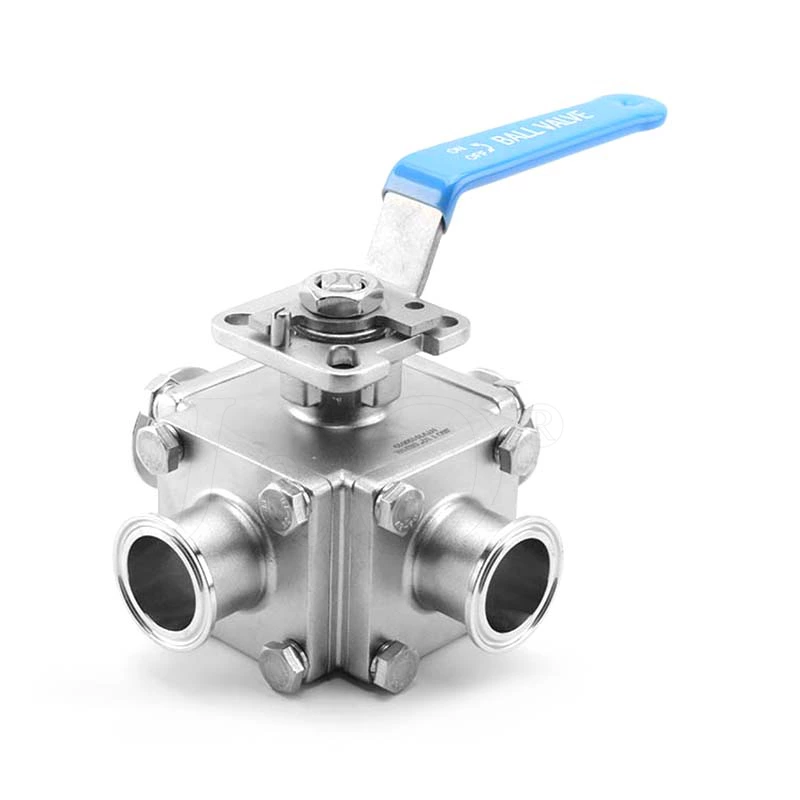The Selection And Shape Of High Platform Ball Valves Are Two Important Factors Affecting Their Air Tightness
The ball support methods of Sanitary Ball Valve are mainly fixed and floating. The following are the characteristics of these two ball support methods:
1. Fixed ball valve: more suitable for high pressure or large diameter applications. Due to the small ball, the deformation of the valve seat is small, the sealing performance is stable, and the service life is extended. The ball of the fixed ball valve is connected to the upper and lower valve stems, and can rotate freely along the axis perpendicular to the valve channel, and cannot move along the channel axis.
2. Floating ball valve: The valve stem is movably connected to the ball, and the ball has no support shaft. Since the ball valve in and out of the ball valve is supported by the valve seat, the ball of the floating ball valve remains straight at both ends and is in a floating state.
Sealing is very important for high platform ball valves and various valves. The sealing performance affects the effect during use. Let's share the sealing performance of the high platform ball valve:
The selection and shape of the high platform ball valve are two important factors affecting its air tightness.
1. The typical preload pressure value of the sealing plate is about 0.1, 1.02 and above the nominal pressure. The adjustment of the preload pressure value of the sealing plate depends on the thickness of the sealing gasket. The sealing performance is related to the gasket thickness error and should be adjusted appropriately. For use.
2. The sealing performance of the ball valve is related to the structure. Different structures have different sealing effects. Only by selecting suitable sealing materials and reasonable structural design can the ball valve provide excellent sealing performance.
The high platform ball valve and flange gate valve are the same type of valves, the difference is that the closing part is a sphere, and the sphere rotates around the center line of the valve body to open and close. The ball valve is mainly used to block, distribute and change the flow direction of the medium in the pipeline.
The working principle of the high platform ball valve is to release or block the valve by rotating the valve. The ball valve switch is light in weight, small in size, large in diameter, sealable, maintainable in structure, with sealing surfaces and spherical surfaces, which are usually closed and corrosion-resistant. By medium degree, it is widely used in various industries. The high platform ball valve can be installed directly with the ball valve through the actuator, but the ordinary ball valve must be installed with an additional bracket.
Some connection methods of high platform ball valve and pipeline are as follows:
1. Flange connection Flange connection is a valve body with flanges at both ends corresponding to the flanges of the pipeline, and the flanges are connected to the pipeline with bolts. Flange connection is a common connection type for high platform ball valves. Flanges can be divided into convex (RF), flat (FF), convex and concave (MF), etc.
2. Butt connection The high platform ball valve is installed between two flanges. The valve body usually has positioning holes for easy installation and positioning. The high platform ball valve and the two pipelines are directly clamped with bolts.
3. Welding butt welding butt: The two ends of the valve body are processed into butt welds according to the butt welding requirements corresponding to the pipeline welds, and fixed to the pipeline by welding. Socket welding connection: Both ends of the valve body are processed according to the socket welding requirements and connected to the pipeline by socket welding.
4. Threaded connection Threaded connection is a simple connection method, which is usually used for small high platform ball valves. The valve body is processed into various thread standards, and there are two types: internal thread and external thread. Corresponding to the thread of the pipeline.
